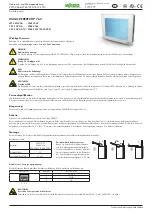
User
Manual
V
ersion 1.21 December, 2018
28
copyright 2018 EVTV LLC
And so this opens the possibility of computers and display devices such as
iPads and iPhones and Androids to access data from “sensors” in
refrigerators, door locks, air conditioners, wrist health monitors, or solar
arrays and present it or otherwise use it.
And so you see how Alexa can turn on lights, lock your door, or manipulate
your thermostat. Fitbit can collect information on how you are sleeping and
present it on your phone. And a brazillion other applications.
As this will be an increasingly important method of tying the world together
via Internet, we added MQTT capability to our ESP32 Tesla Battery Module
controller and Battery Display more as a learning exercise than anything
else.
Using MQTT is entirely optional. If you do use it, understand that EVTV
could peer into your solar energy storage data as we provide the necessary
Amazon IoT core broker for this to work. And no, the security credential
certificate issues are too impossibly icky for us to make it where you can set
up your own broker. In theory….well perhaps in the future….
Let’s go back to our configuration screen. Note the
Use MQTT
check box.
If you enable this, the system uses MQTT I
NSTEAD
of UDP. If you
uncheck it , it uses UDP through the local AP.
There are also two elements for IDs. The
BMS ID
is the important one. This
is the ClientID of the ESP32 Battery Module Controller and is entered on
the configuration screen of that device. The
BMS ID
here must match that
exactly.
The
Display ID
can be anything. We just need a unique client ID for the
display itself. Ensure you have a different client ID for each EVTV Battery
Display you use.
SAVE those configuration items by touching the SAVE icon. Then power
cycle the Display and on boot up, it will establish a connection to the EVTV
broker on Amazon as the
Display ID
. It will also SUBSCRIBE to the topics
















































